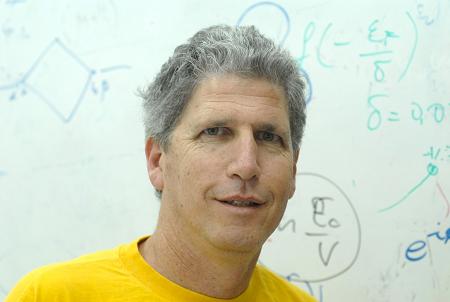Prof. Yigal Meir from the Department of Physics and the Ilse Katz Center at Ben-Gurion University for research in the nanoscale and mesoscopic field has solved a mystery that has occupied the researchers in the field of nanoelectronics for about twenty years. His findings were recently published in the prestigious journal Nature

Prof. Yigal Meir. Photographer: Danny Machlis, Ben-Gurion University.
Prof. Yigal Meir from the Department of Physics and the Ilse Katz Center at Ben-Gurion University for research in the nanoscale and mesoscopic field has solved a mystery that has occupied the researchers in the field of nanoelectronics for about twenty years. His findings were recently published in the prestigious journal Nature.
Nanoelectronics deals with the passage of electrons through miniature devices, the size of which is measured in nanometers (billionths of a meter). The most basic unit of such structures is called a "quantum bottleneck". Such a device can be described as a very narrow transition between two reservoirs of electrons. The wider the passage, the greater the movement of electrons through it, i.e. the conductivity of the device. Quantum theory shows that the flow of electrons passing through the transition has a wave character (like a light beam), and therefore the scientists estimated that the change in electrical conductivity, with the expansion of the "bottle neck", will not be continuous but will be characterized by a kind of "jumps", with the size of each such step being uniform and known in advance. Experiments conducted indeed verified this assessment, with one change: in addition to the expected steps, another, unexplained step was observed in the experiments, named after its size "anomaly - 0.7". The phenomenon was first observed in 1988, but until recently remained one of the unsolved mysteries in the field.
Prof. Meir and his colleague Prof. Ned Wingreen from Princeton University proposed a solution to a puzzle that troubled many scientists a few years ago: an electron is trapped in the neck of the bottle itself and creates a disturbance that explains the anomaly. The theory quantitatively explained the characteristics of the phenomenon, but it was still necessary to explain the capture of the electron during the transition, which seemed illogical to the researchers (this is similar to the formation of a puddle of water at the top of a hill). The explanation is now given by Meir and Kreitman's colleague Dr. Thomas Reitz. Meir and Reitz calculated how the movement of the electrons and the electric forces they create around the "bottleneck" cause a single electron to be trapped at the transition point and thus proved the correctness of the solution to the mystery.
An electron trapped in such a bottleneck may make it difficult for "quantum computers" to function - one of today's popular research directions in the field of nanoelectronics, which, if realized, will cause a major revolution in the entire field of computing; But understanding the conditions under which an electron is trapped, as revealed in the work of Meir and Reitz, will provide researchers with tools to deal with the phenomenon and prevent it.

One response
Cool!